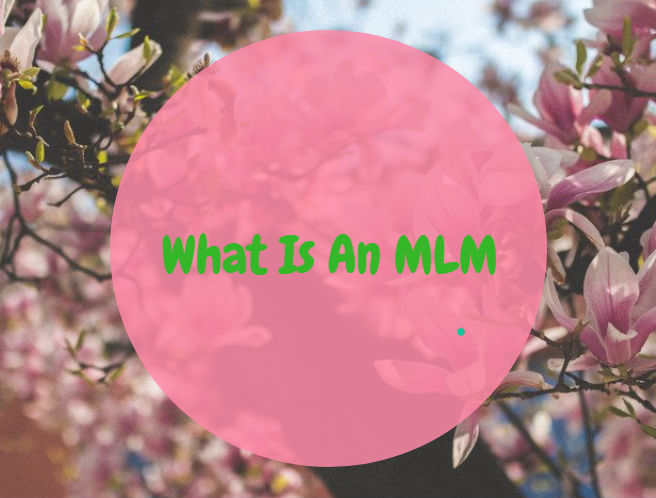
What is an MLM
MLMs are not pyramid schemes but can function in a similar way. All traditional retail functions the same way, so what’s the danger in MLMs? Can you make money?
MLMs were once an excellent way to start a small home-based business and make a little money on the side. These days, I prefer a more modern way of making money from home, by building an affiliate marketing business.
If that may appeal to you, here’s my preference for how to get started now.
Product Name: MLMs in general
Website : vary
Price : Vary
Owner : vary
Ranking : Be careful
This a long article because the subject, MLMs is an important one. Each paragraph has a subtitle, so you can read all through or skip the ones you already know about.
What are MLMs
The definition of MLMs varies and some definitions are completely wrong.
Let’s look at traditional retail and see where the differences are between retail and MLMs They are not so different. In fact, the principles are pretty much the same, so why do MLMs have such a bad name?
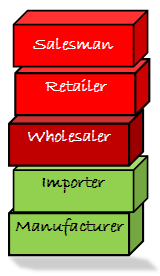
You can see that in the retail stack the
- Manufacturer of a product sells to an importer
- The Importer sells to a Wholesaler
- The Wholesaler sells to a retailer
- The Retailer Sells to a salesman.
- The Salesman sells to a customer.
This model can be complicated by “Exporters” and “Cash and Carry” Warehouses etc. but the principle is that each layer of the stack buys in different quantities and gets a discount on the price they pay.
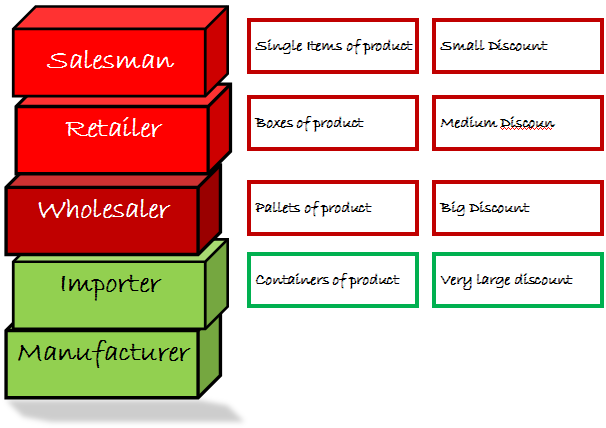
Modern variations can include drop shippers and affiliate marketers, but that is another story.
I will keep it simple here because the principles of an MLM are the same.
All 5 of these levels are buying and selling the products except that usually, the salesman sells on behalf of the retailer, (s)he does not usually own any product.
The lower down in the retail stack you are, the larger the numbers of the product you must shift in one sale
Let’s look at the MLM stack:
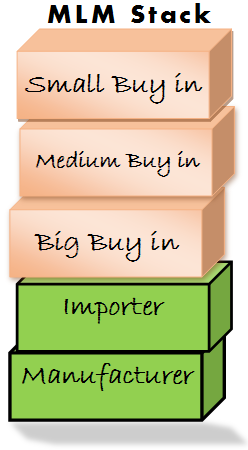
Here the MLM product is not usually advertised by the company, wholesaler etc.
The product is bought in by the top 3 levels and the commission or profit each level makes depends on how much product they buy.
In MLMs the more you buy, the cheaper the product.
This is the same as in retail.
The idea is that by saving on overheads like advertising, MLMs have more profit to share among the different levels.
This is not always true in MLM companies.
What is MLM About?
Well, there are actually two ways to make money in MLM.
- Selling MLM product to customers.
- Recruiting new members, into the MLM, who buy in some product from you to become a member of the MLM team.
This is where the problems start with MLMs.
There are financial incentives called “over-riders.” These are small commissions which a team member makes from anyone he has recruited, when they buy product.
These recruited members are often referred to as your “Downline” or “Up line.” It means the same thing.
Looking at a typical MLM structure:
- You recruit 10 people who buy in at the cheapest level of the MLM.
- They each buy MLM product from you at a small discount.
- You have sold 10 times the product through your MLM downline.
Each one of those 10 recruits 10 more people. You now have 110 people in your downline.
The 100 buy product from the 10 who buy it from you. You get a small commission on the 100 sales.
The 100 now recruit a further 10 each, 100 x 10 = 1000 more into your MLM downline. All have bought some product and you get a small commission on what they have bought.
You now have an MLM downline of 10 + 100 + 1000 = 1,110 people, all effectively selling product and recruiting people into your downline.
- You
- 10
- 100
- 1000
If all these people also sell a little product each month as well as recruiting new people, your total turnover of product, in this MLM, will increase massively and you will be able to buy even cheaper.
That is a simple way of looking at MLMs.
It looks really easy and a guaranteed success, doesn’t it?
Why Do MLMs Fail?
- The recruitment model in MLMs is unrealistic.

On the basis of my previous example of each person recruiting 10 people per month into the MLM: This is how the downline grows. (Note that I have only gone down 5 levels.)
- Look at the total downline after 12 months. 901,221 people.
- Imagine you are selling perfume and beauty products.
- Imagine you live in “Townsville” of population 250,000.
- Are there really going to be nearly a million people wanting to buy and sell these beauty products through MLM?
- At what point have you recruited everybody in the town? (6 months!)
I think that is pushing the limits of credibility.
- The products are rarely supported by TV, internet or national advertising. This makes it difficult to sell the products to many people. Generally, people like to buy from a recognised brand.
Plenty of places sell burgers and milkshakes, but what name comes to mind when you think of them?
- Despite the savings by not advertising and the low stock levels needed, the products are often overpriced when compared with high street brands.
What Do MLMs Do?
MLMs have taken the ordinary retail model and allowed people to “buy” in to a business.
- without carrying large amounts of stock
- without premises and
- without employing staff.
In theory, this reduces the cost of the business and the cost of the products.
In reality, this rarely is the truth.
e.g. Jim is a wholesaler,
- He needs to have large buildings to store all the pallets of stock he needs.
- He needs computers and software to control his stock and sales
- Staff to load and unload and do the Administration.
- Insurance to protect his goods
- Trucks to transport the goods to retailers
- He needs to sell his goods.
- Large quantities of products.
He has enormous responsibilities and a large investment.
Jim’s wife, Clara, has joined an MLM and bought in at a good discount.
- She carries a little stock for demonstration purposes.
- Most of her “stock” is sold when she recruits new members.
- Some of her stock is sold when her members (downline) recruit new members.
- She only meets and sells to a few customers herself.
- She has no large premises,
- She has no employees
- She has no trucks
- She has no insurance.
- She has few responsibilities and she gets her initial MLM investment back quickly.
The differences between the traditional model and the MLM one are quite profound, so why doesn’t MLM work?
See the section on “Why MLMs Fail,” then add in this:
Because the need to make money is a driving force in most of us, it looks easier than it really is.
The promise of “Just recruit 10 people a month to be a millionaire by Christmas,” is so seductive.

Reality is that recruiting people, into an MLM, is a highly skilled and challenging job. Once you have recruited your family and close friends, it becomes painfully clear that
- You cannot recruit the whole of your town. (The Whole country?)
- Whatever product you sell, there must be buyers for that product.
- A point comes when finding customers for your product is very difficult. Saturation point is reached.
MLM Facts
If you recruit 2 new people a month into the MLM and they recruit 2 people a month, after 1 year your MLM downline would be about 8,190 people.
If they each sold $100 of product each month and you made 5% of that, you would earn 5% 0f 8,190 of $100 =$40,950 per month.
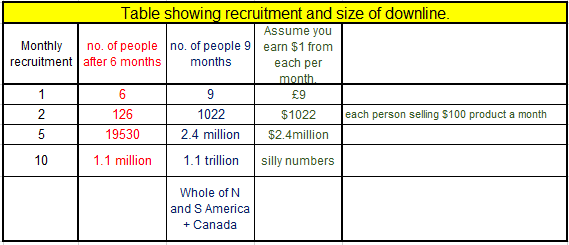
As of 2018, there are only 10 towns in the U.S.A. that have a population of over 1 million.
Here are a few basic figures based on recruitment to the MLM and how your downline would grow, depending on how many people you recruited per month.
- If each person recruits 2 people per month, after 9 months you will have a downline of 1022 people.
- If each person sells $100 of product a month and you get $1 commission on that – you will make $1,022 each month.
- Each person will make a profit of about $10 a month. Not really good.
- Recruiting 3 people each per month, you will have recruited the total population of the towns of Austin, Texas or San Francisco, California. All within 9 months.
- Recruiting 5 people per month you have sucked in Chicago in 9 months.
Since the amounts earned are so poor in MLMs generally, people will look at recruiting more people to increase their earnings. But, there is a problem?
- If everybody recruits 5 people per month, your downline has grown to 2.4 million people after 9 months
- If everybody recruits 10 people per month, your downline has grown to 1.111,111,110 people.
CONGRATULATIONS, in 9 months you have recruited the whole of North, South America and Canada to your MLM downline. Are you getting the picture? The numbers look crazy because they are crazy.
The Secrets of How MLMs Really Work
- MLMs rely on people buying product as consumers/members and then giving up recruiting and selling.
- Only the people at the top and the beginning really make money.
- Generally, an MLM based on consumables works better than on luxury goods.
- Professional MLM experts rely on a downline they transfer from one MLM project to the next.
- Many people love MLMs (Network Marketing,) in the eternal belief that the next MLM will be the one that makes them rich.
How to Make Real Money from an MLM
- Start your own MLM company.
- Recruit networkers into your MLM with large active downlines already.
- Build a good large downline yourself in your own MLM.
- Make agreements with other MLM companies that you will bring your downline / network into their company, only if you have a top slot in their new company.
The Good MLM Companies
- Amway Home Care
- Avon Beauty
- Herbalife Supplements
- Mary Kay Beauty
- Nu Skin Beauty
- Tupperware Food Storage containers.
- Melaleuca Home Care
- Primerica Primerica
- Rodan and Fields Beauty
- Jeunesse Supplements
- Vorwerk & Co. Household beauty and scientific
This is based on their revenue for 2017 and is not a complete or a definitive list.
In the UK, my personal top 10 is (not in order:)
- Tupperware Food Storage
- Utility Warehouse Utilities, phones
- Amway Household
- Herbalife supplements
- Forever Living Supplements health
- Mary Kay Beauty
- Avon Beauty
- Arbonne International Beauty
- Nu Skin Supplements
- Vorwerk & Co. Household beauty and scientific
The UK market is a little different from the USA one because people’s attitudes to MLMs are quite different. The product markets are quite different as well. Note that some of the longer running MLM are good on both sides of the Atlantic.
This is based on how long the MLMs have been established and their reputation for success. (How many people give up after a short time.)
N.B. these are not definitive lists. There are more good MLMs and plenty of poor ones.
What do MLM Companies Sell?
About 39% of MLM companies sell Supplements.
About 15% of MLM companies sell Beauty products.
Of the largest MLMs, over half sell beauty products. Many of the supplement based companies market their products as health or beauty products.
Anti-aging products in MLMs are beginning to trend upwards as well.
The Good in MLMs
It is possible to start with relatively low capital.
If you enjoy meeting and talking to people and are passionate about your products, it is possible to make money.
It is something you can study, learn about and become good at.
The Bad in MLMs
There are too many to mention because the marketing model in MLMs is basically flawed. (See statistics above.)
The MLM product needs to be saleable (price and popularity.) they are often expensive and not a recognisable brand.
The profit, as a distributor in an MLM, needs to be big enough to make money without forcing the member to recruit. Most MLMs fail here.
The memberships in MLMs are sold to people on the basis of the potential to make a lot of money quickly. It is NOT possible. It is necessary to learn a trade or skill and MLM marketing involves skills which most people do not have.
When is an MLM not an MLM?
When it is a Pyramid Scheme or a Ponzi Scheme.
The fundamental difference between an MLM and a Pyramid scheme is that in a pyramid scheme:
- You have to recruit
- There is no real or viable product.
- The “false” product is often the membership of the Pyramid scheme itself.
I am not going to name any “bad” MLMs because that could lead to some bad feeling which is unuseful.
A Ponzi Scheme is when the old recruits are paid out of the new recruit’s investment. This scheme will eventually burst when too many people want their money back.
There are stories of massive Ponzi schemes ripping of people for millions.
Who is an MLM for?
You will need to have an interest in and use the products yourself.
With the reputable MLM companies, it is possible to make some money if you have a wide circle of friends and family who share your passion for the product.
If you are looking at making a lot of money, start your own MLM.
Who is an MLM Not for?
Someone who wants to join an MLM and just recruit.
Someone who needs to replace their current income quickly.
Tools and Training in MLMs
MLMs often have internal training and there are some good YouTube training videos on the general subjects of
- Organisation in MLMs
- MLM recruiting
- Training of distributers in MLMs and
- Motivation of distributors in MLMs.
I am not linking to any specific because there are always new ones coming along and they might be even better. You can research these yourself under those headings.
The person who recruited you should also be responsible for training you and supporting you through the MLM company.
Support in MLMs
Support comes primarily from your MLM up line or recruiter.
Most MLMs have a system of support, training and encouragement. You will need:
- MLM Product knowledge
- MLM System knowledge (how to order products for example.)
- Motivation and encouragement
- Knowledge of how to build a good MLM network.
- How to organise your own work day and set your own goals.
Pricing and Upsells in MLMs
This varies a lot, depending on the structure of the MLM and the type of product sold.
Balance Pros and Cons
There are some advantages to starting your own business these days especially on the internet which is still in massive growth.
I personally have tried several MLMs with varied success. It is a challenging business to sustain over the long term.
I prefer the more modern way of marketing, affiliate marketing. It has all the good characteristics of
- A very low start-up cost.
- It is scalable so can grow as you are learning.
- There is no limit to the earnings.
- You can run it yourself without depending on recruiting.
- You can run it from home.
- You have no need of stock or premises.
- It is in a growth market.
- You can promote quality, well-known, brands.
- I could go on, and on.
There was a time when MLMs were the best way to start a small business up from home and they opened up opportunities to many people. They are still viable but there are other, better, opportunities.
MLMs, a Scam or Not?
Sometimes MLMs are a scam, when they are based on poor products and you need to recruit people.
Some of the good MLMs are not a scam and if you check them out carefully, you may well be on to a winner.
Product Name: MLMs in general
Website : vary
Price : Vary
Owner : vary
Ranking : Be careful
Verdict: MLM, Recommended or Not?
I cannot recommend MLMs as a modern way to start a business from home.
Affiliate marketing has many different forms and most involve either websites or social media, which most people are familiar with. Imagine using YouTube to make money?
This review is my personal opinion based on some years of experience and a lot of really excellent training. I have made mistakes and I have learnt some expensive lessons. Those lessons have usually been due to believing the emotional hype that is used by unscrupulous people. Their attempts to draw people in to buying their programmes often follows a recognisable pattern.
If you have experienced similar problems, especially with the programs reviewed here, please do comment. We welcome honest views of all kinds.
If you are interested in a genuine free trial of an excellent training platform, click here. No obligation.



Great and informative. Thank you so much for sharing your knowledge. I do hope someone just starting off reads what you have shared. It could just help them to make a better decision. I too like the affilate aspect much better than mlm. Too many variations in my opinion.
Great info!
Thanks Susan.
There were some really good MLM companies but too many have jumped on the bandwagon of recruitment instead of quality goods at a decent price.
Social habits are changing with the advance of internet communications and we tend to use Facebook, Twitter etc much more than face to face meetings. I’m not sure that is good for us but it does make MLM recruitment very challenging.
Good luck with your projects.
Very valuable information. I have tried different MLM’s and like you say it is difficult but can be accomplished if you have LOTS of people to talk to and are comfortable with the wait. I too have decided affilate marketing is a better way to go! Thanks for sharing your knowledge!
Thanks Susan,
Good luck with your affiliate marketing. I hope you have great success with it.
Affiliate marketing is definitely the modern way to do business and it is growing every day.